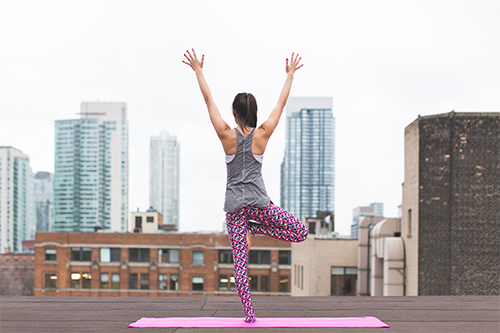You know squats tone your legs and crunches target your core. But what workouts are best for your heart?
The short answer: aerobic exercises, aka cardio. That’s because aerobic exercise can decrease inflammation, which lowers the risk of atherosclerosis, or fatty buildups in the arteries that can eventually lead to heart disease, according to researchers. But, to get even more specific, and in honor of Heart Health Month, we’ve turned to trainers and scientific studies to find out which workouts are best for our tickers.
These workouts and tips are sure to get your heart pumping. Plus, make sure you check out these 28 simple ways to improve your heart health.
1. Try HIIT workouts
When it comes to heart-healthy workouts, HIIT is a favorite among trainers and health professionals. For the uninitiated, HIIT stands for High Intensity Interval Training and these workouts shuffle between short bursts of intense workouts where you really push your limits, and brief periods of less-intense activities. The American College of Sports Medicine says this method of exercise helps torch more calories because your body is still burning calories post-workout.
“As long as HIIT is done regularly, fitness and endurance levels improve, and so does cardiovascular health since the heart and lungs work together at peak performance,” explains fitness trainer Miriam Amselem.
She suggests people do three, 20-minute HIIT sessions per week. First, do a five-minute warmup. (Those with heart disease should consult their physician before giving HIIT workouts a try, Amselem says).
Some 20-minute HIIT workout ideas for varying fitness levels that Amselem suggests include:
- Speed walking for one minute, then walking at a slower pace for a minute.
- Sprinting for one minute, then jogging for one minute.
- Swimming in the lap lane as fast as possible for one minute, then taking slower laps for the next minute.
Also, as Harvard Health points out, many gym machines — including treadmills, ellipticals, and stationary cycles — have a built-in interval training function that will move people through the exercises.
An added bonus of HIIT? It’s highly efficient. Health and fitness expert Stephanie Mansour, who is CEO of Step It Up With Steph and a Chicago-based personal trainer, has a DVD program that can guide you through a half-hour, full-body workout at home with just a yoga mat and set of dumbbells. Her workout blends HIIT training with Pilates, yoga, and stretching, and includes modifications and low-impact options.
2. Mix cardio and strength training

Sure, cardio workouts are great for cardiovascular health. But don’t ditch the dumbbells! Lifting weights is similar to interval training because your heart rate increases during sets, and has a chance to recover in between sets. Kelly Zook, head trainer at Burn Boot Camp Long Grove, recommends a regimen of both strength training and cardiovascular workouts.
“The two work together in keeping the heart healthy by getting rid of excess body fat, lowering blood pressure, maintaining cholesterol levels, and decreasing stress,” Zook says. Incorporating knee sprinters, jumping jacks, squats, and push-ups are all great for improving heart health.
3. Give kickboxing a try
Kickboxing and boxing are favorite heart-healthy workouts of Christian Koshaba, a Chicago native and certified personal trainer who owns Three60Fit. “It can be done with little to no equipment,” he says. Plus, it can fall into the HIIT training category that’s great for reducing the risk of heart disease and helping regulate blood pressure, Koshaba says. On top of all that, kickboxing is a great stress reliever.
4. Combine cardio with yoga

Adding yoga to your workout mix can be a boon for your heart health, according to 2017 research from the American College of Cardiology. A study found that heart disease patients who incorporated yoga in addition to their cardio workouts saw twice the reduction in blood pressure, body mass index, and cholesterol levels when compared to those patients who just practiced yoga or aerobic exercise alone. The researchers concluded that combining yoga and aerobic exercise could reduce mental, physical, and vascular stress.
5. Get 30 minutes of exercise per day
To improve overall cardiovascular health, the American Heart Association recommends at least 150 minutes per week of moderate exercise or 75 minutes per week of vigorous exercise.
But, for extra credit, challenge yourself to at least 30 minutes of exercise each day, even if its moderate. Some benefits of reaching this goal? You can lower your blood pressure by 5 to 10 millimeters of mercury (mm Hg), according to the Mayo Clinic. In some cases, that might be enough to prevent or reduce the need for blood pressure medications. Exercising daily can also increase the concentration of high-density lipoprotein, or “good cholesterol.”
You don’t have to get all 30 minutes in at a time, either. Squeeze in some extra workout time at home with Andrea Metcalf, a Chicago certified personal trainer and certified nutritionist. Her Keeping Fit 3-Pack contains a mix of strength training, cardio, and core conditioning. Each program is broken up into 10 five-minute workout blasts so you can knock out a couple segments when you’ve got a 10-minute break in your day.
6. Go for a run

It’s no surprise that running is the heart-pumping exercise of choice for Meghan Kennihan, a Chicago certified personal trainer and running coach. But science is backing her up: Studies have shown that running can help prevent obesity, type 2 diabetes, heart disease, high blood pressure, and strokes. Plus, a 2014 study from Iowa State University, published in the “Journal of the American College of Cardiology,” found running for just five or 10 minutes a day can significantly reduce your risk of death from cardiovascular disease.
“You don’t have to just run,” says Kennihan. “Ease into it by starting with a run-walk program to get started.” Her fave spot for a run? Waterfall Glen, a 10-mile loop with some hills, although you could do just a portion of the trail.
7. Try some deskercise
First some bad news: Sitting for prolonged periods can be bad for your cardiovascular health, according to research from UT Southwestern Medical Center. In fact, two hours of sitting can be just as harmful as 20 minutes of exercise is beneficial. While quitting your desk job isn’t exactly an option, cardiologist recommend taking short walks during lunch and throughout the day, using a pedometer to track steps, taking the stairs instead of the elevator, and hosting walking meetings at work. Swapping out your desk chair for a standing or treadmill desk would also be helpful.
More from Make It Better:
- The 8 Best Teas For Your Health
- The Complete Guide to Working Out at Home
- 5 Safety Tips You Should Always Employ While Jogging

Brittany Anas is a freelance writer who specializes in health, fitness and travel writing. She also contributes to Men’s Journal, Women’s Health, Trip Savvy, Simplemost, Orbitz, and Eat This, Not That! She spent a decade working at daily newspapers, including The Denver Post and the Daily Camera in Boulder, Colorado, and she is a former federal background investigator. In her free time, Brittany enjoys hiking with her gremlin-pot belly pig mix that the rescue described as a “Boston Terrier” and coaching youth basketball. She also works with domestic abuse survivors, helping them regain financial stability through career coaching. Follower her on Twitter and Instagram.

